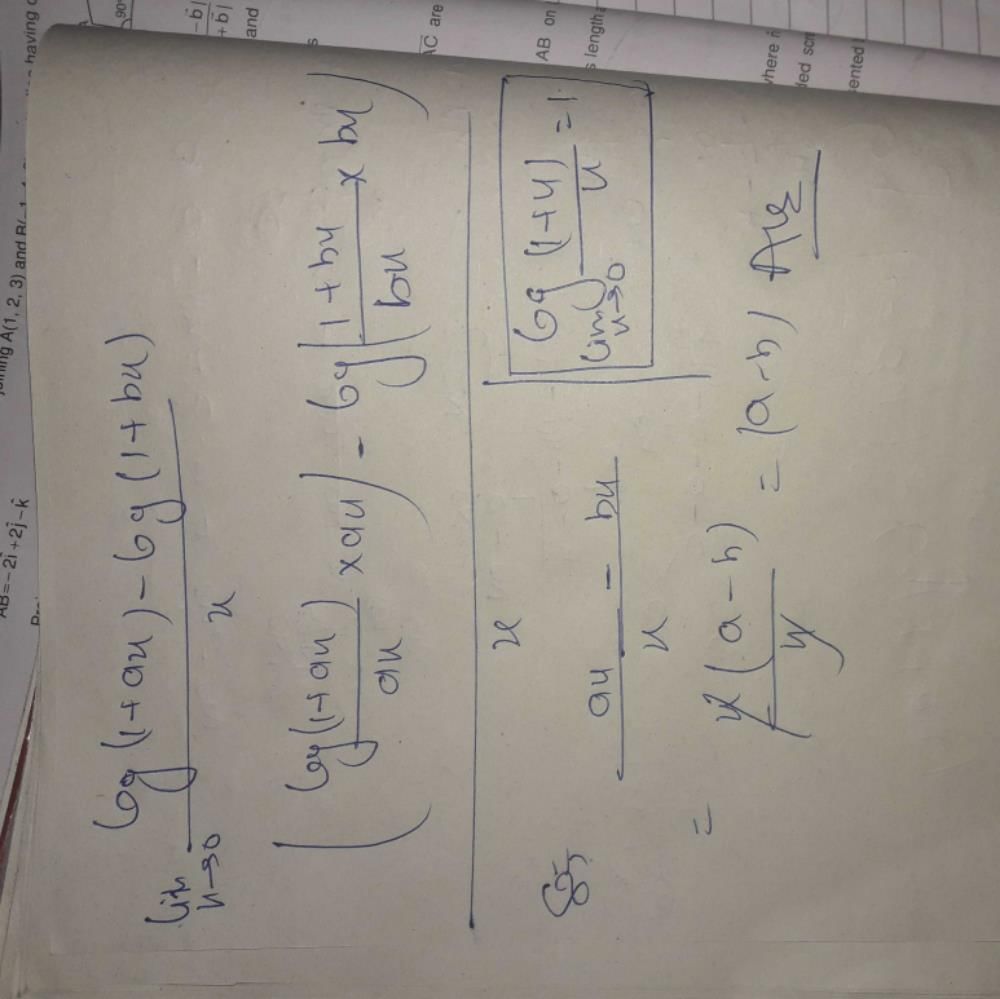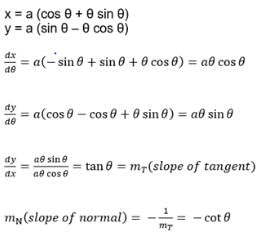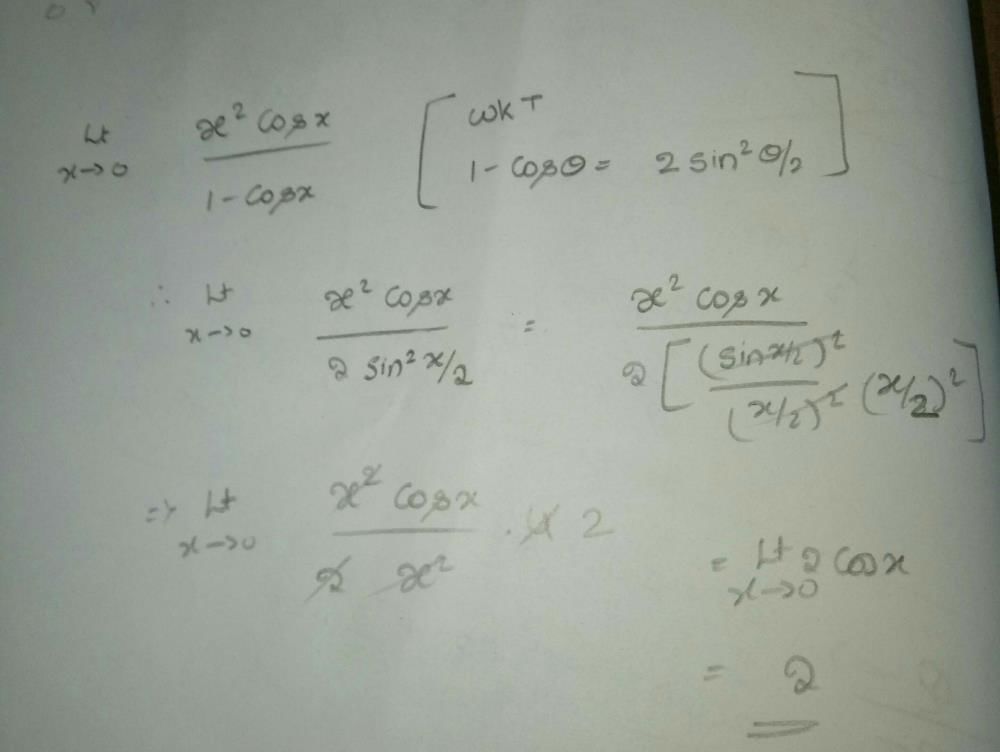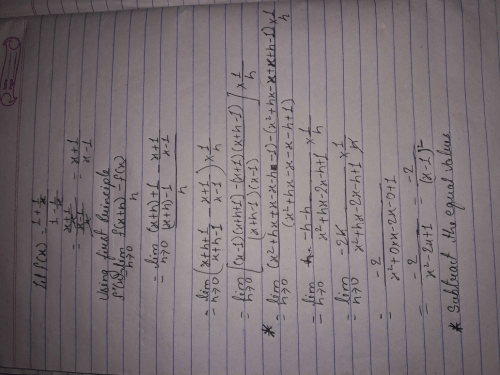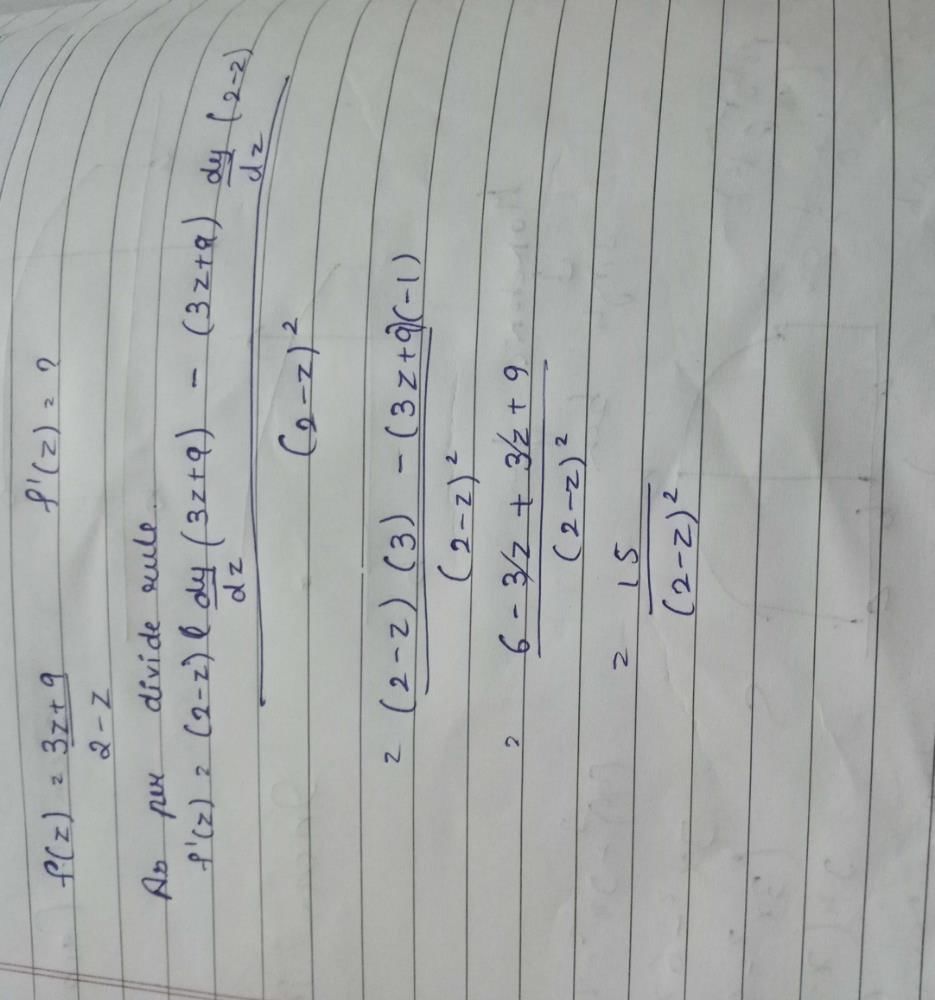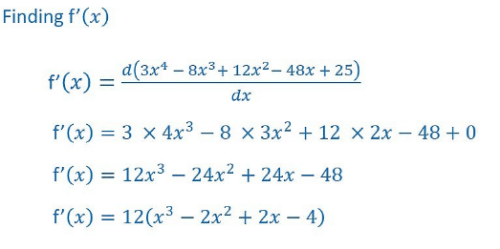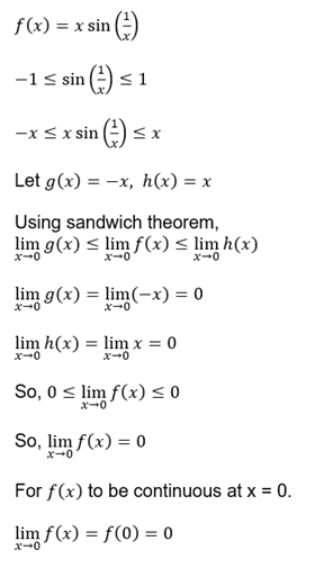All Exams >
JAMB >
Mathematics for JAMB >
All Questions
All questions of Differentiation & Its Applications for JAMB Exam
Using approximation find the value of 
- a)2.025
- b)2.001
- c)2.01
- d)2.0025
Correct answer is option 'D'. Can you explain this answer?
Using approximation find the value of 
a)
2.025
b)
2.001
c)
2.01
d)
2.0025

|
Gunjan Lakhani answered |
Let x=4, Δx=0.01
y=x^½ = 2
y+Δy = (x+ Δx)^½ = (4.01)^½
Δy = (dy/dx) * Δx
Δy = (x^(-1/2))/2 * Δx
Δy = (½)*(½) * 0.01
Δy = 0.25 * 0.01
Δy = 0.0025
So, (4.01)^½ = 2 + 0.0025 = 2.0025
The maximum value of f (x) = sin x in the interval [π,2π] is
a) 6
b) 0
c) -2
d) -4
Correct answer is option 'B'. Can you explain this answer?
|
|
Kiran Mehta answered |
f(x) = sin x
f’(x) =cosx
f”(x) = -sin x
f”(3pi/2) = -sin(3pi/2)
= -(-1)
=> 1 > 0 (local minima)
f(pi) = sin(pi) = 0
f(2pi) = sin(2pi) = 0
Hence, 0 is the maxima.
f’(x) =cosx
f”(x) = -sin x
f”(3pi/2) = -sin(3pi/2)
= -(-1)
=> 1 > 0 (local minima)
f(pi) = sin(pi) = 0
f(2pi) = sin(2pi) = 0
Hence, 0 is the maxima.

- a)1
- b)1/3
- c)1/2
- d)0
Correct answer is option 'B'. Can you explain this answer?
a)
1
b)
1/3
c)
1/2
d)
0
|
|
Krishna Iyer answered |
lim(x → 0) (tanx-x)/x2 tanx
As we know that tan x = sinx/cosx
lim(x → 0) (sinx/cosx - x)/x2(sinx/cosx)
lim(x → 0) (sinx - xcosx)/(x2 sinx)
lim(x → 0) cosx - (-xsinx + cosx)/(x2cosx + sinx (2x))
lim(x → 0) (cosx + xsinx - cosx)/x2cosx + 2xsinx)
lim(x → 0) sinx/(xcosx + 2sinx)
Hence it is 0/0 form, apply L hospital rule
lim(x → 0) cosx/(-xsinx + cosx + 2cosx)
⇒ 1/(0+1+2)
= 1/3
As we know that tan x = sinx/cosx
lim(x → 0) (sinx/cosx - x)/x2(sinx/cosx)
lim(x → 0) (sinx - xcosx)/(x2 sinx)
lim(x → 0) cosx - (-xsinx + cosx)/(x2cosx + sinx (2x))
lim(x → 0) (cosx + xsinx - cosx)/x2cosx + 2xsinx)
lim(x → 0) sinx/(xcosx + 2sinx)
Hence it is 0/0 form, apply L hospital rule
lim(x → 0) cosx/(-xsinx + cosx + 2cosx)
⇒ 1/(0+1+2)
= 1/3
Find the maximum and minimum values of f (x) = 2x3 – 24x + 107 in the interval [1, 3].- a)89, 69
- b)89, 75
- c)59, 56
- d)89, -9
Correct answer is option 'B'. Can you explain this answer?
Find the maximum and minimum values of f (x) = 2x3 – 24x + 107 in the interval [1, 3].
a)
89, 69
b)
89, 75
c)
59, 56
d)
89, -9
|
|
Anjana Sharma answered |
Toolbox:d/dx(x^n) = nx^n−1Maxima & Minima = f′... more(x) = 0Step 1:f(x) = 2x^3−24x+107Differentiating with
Find the maximum profit that a company can make, if the profit function is given by P(x) = 41 + 24 x – 18x2- a)56
- b)49
- c)23
- d)89
Correct answer is option 'B'. Can you explain this answer?
Find the maximum profit that a company can make, if the profit function is given by P(x) = 41 + 24 x – 18x2
a)
56
b)
49
c)
23
d)
89
|
|
Aryan Khanna answered |
p’(x) = -24 - 36x
p”(x) = -36
Now, p’(x) = 0 ⇒ x = (-24)/36
x = -⅔
Also, p”(-⅔) = -36 < 0
By the second derivative test, x = -⅔
Therefore, maximum profit = p(-⅔)
= 41 - 24(-⅔) - 18(-⅔)^2
= 41 +16 - 8
⇒ 49
p”(x) = -36
Now, p’(x) = 0 ⇒ x = (-24)/36
x = -⅔
Also, p”(-⅔) = -36 < 0
By the second derivative test, x = -⅔
Therefore, maximum profit = p(-⅔)
= 41 - 24(-⅔) - 18(-⅔)^2
= 41 +16 - 8
⇒ 49
A stone is dropped into a quiet lake and waves move in circles at a speed of 2cm per second. At the instant, when the radius of the circular wave is 12 cm, how fast is the enclosed area changing ?- a)Decreasing at the rate of 48π cm2 / sec
- b)Increasing at the rate of 24π cm2 / sec
- c)Increasing at the rate of 48π cm2 / sec
- d)Decreasing at the rate of 24π cm2 / sec
Correct answer is option 'C'. Can you explain this answer?
A stone is dropped into a quiet lake and waves move in circles at a speed of 2cm per second. At the instant, when the radius of the circular wave is 12 cm, how fast is the enclosed area changing ?
a)
Decreasing at the rate of 48π cm2 / sec
b)
Increasing at the rate of 24π cm2 / sec
c)
Increasing at the rate of 48π cm2 / sec
d)
Decreasing at the rate of 24π cm2 / sec
|
|
Hansa Sharma answered |
Rate of increase of radius dr/dt = 2 cm/s
Area of circle A = πr2
dA/dt = π*(2r)*(dr/dt)
= π*(24)*2
= 48π cm2/s
Rate of increase of area is 48π cm2/s (increasing as it is positive).
Area of circle A = πr2
dA/dt = π*(2r)*(dr/dt)
= π*(24)*2
= 48π cm2/s
Rate of increase of area is 48π cm2/s (increasing as it is positive).
Let (tan α) x + (sin α) y = α and (α cosec α) x + (cos α) y = 1 be two variable straight lines, α being the parameter. Let P be the point of intersection of the lines. In the limiting position when α→ 0, the coordinates of P are- a)(2 , 1)
- b) (–2 ,–1)
- c)(–2 , 1)
- d)(2 , –1)
Correct answer is option 'D'. Can you explain this answer?
Let (tan α) x + (sin α) y = α and (α cosec α) x + (cos α) y = 1 be two variable straight lines, α being the parameter. Let P be the point of intersection of the lines. In the limiting position when α→ 0, the coordinates of P are
a)
(2 , 1)
b)
(–2 ,–1)
c)
(–2 , 1)
d)
(2 , –1)

|
Maths Learner answered |
Can anyone explain the question and concept
Find the approximate value of f(10.01) where f(x) = 5x2 +6x + 3- a)564.06
- b)564.01
- c)563.00
- d)563.01
Correct answer is option 'A'. Can you explain this answer?
Find the approximate value of f(10.01) where f(x) = 5x2 +6x + 3
a)
564.06
b)
564.01
c)
563.00
d)
563.01
|
|
Naina Sharma answered |
f(x) = 5x2 +6x + 3
f(10.01) = 5*(10.01)2 + 6*(10.01) + 3
To find (10.01)2
Let p=10, Δp=0.01
y=p2 = 100
y+Δy = (p+ Δp)2 = (10.01)2
Δy = (dy/dp) * Δp
Δy = 2*p* Δx
Δy = 2*10* 0.01
Δy = 20 * 0.01
Δy = 0.2
So, (10.01)2 = y + Δy
= 100.2
So,
f(10.01) = 5*(100.2) + 6*(10.01) + 3
= 501 + 60.06 + 3
= 564.06
f(10.01) = 5*(10.01)2 + 6*(10.01) + 3
To find (10.01)2
Let p=10, Δp=0.01
y=p2 = 100
y+Δy = (p+ Δp)2 = (10.01)2
Δy = (dy/dp) * Δp
Δy = 2*p* Δx
Δy = 2*10* 0.01
Δy = 20 * 0.01
Δy = 0.2
So, (10.01)2 = y + Δy
= 100.2
So,
f(10.01) = 5*(100.2) + 6*(10.01) + 3
= 501 + 60.06 + 3
= 564.06
The total revenue in Rupees received from the sale of x units of a product is given by R(x) = 5x2 + 22x + 35. Find the marginal revenue, when x = 7, where by marginal revenue we mean the rate of change of total revenue with respect to the number of items sold at an instant- a)Rs 7
- b)Rs 127
- c)Rs 92
- d)Rs 48
Correct answer is option 'C'. Can you explain this answer?
The total revenue in Rupees received from the sale of x units of a product is given by R(x) = 5x2 + 22x + 35. Find the marginal revenue, when x = 7, where by marginal revenue we mean the rate of change of total revenue with respect to the number of items sold at an instant
a)
Rs 7
b)
Rs 127
c)
Rs 92
d)
Rs 48
|
|
Gaurav Kumar answered |
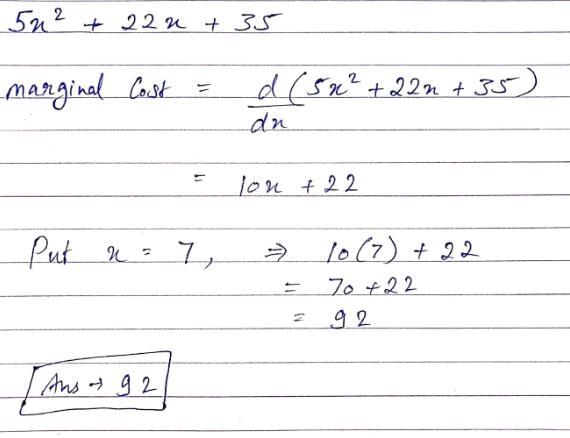
The radius of air bubble is increasing at the rate of 0. 25 cm/s. At what rate the volume of the bubble is increasing when the radius is 1 cm.- a)4π cm3/s
- b)22π cm3/s
- c)2π cm3/s
- d)π cm3/s
Correct answer is option 'D'. Can you explain this answer?
The radius of air bubble is increasing at the rate of 0. 25 cm/s. At what rate the volume of the bubble is increasing when the radius is 1 cm.
a)
4π cm3/s
b)
22π cm3/s
c)
2π cm3/s
d)
π cm3/s
|
|
Rohan Yadav answered |
Given, the rate of increase of radius of the air bubble = 0.25 cm/s
We need to find the rate of increase of volume of the bubble when the radius is 1 cm.
Formula used:
Volume of a sphere = (4/3)πr^3
Differentiating both sides with respect to time t, we get:
dV/dt = 4πr^2(dr/dt)
where dV/dt is the rate of change of volume of the sphere with respect to time t and dr/dt is the rate of change of radius of the sphere with respect to time t.
Substituting the given values, we get:
dV/dt = 4π(1)^2(0.25) = π cm^3/s
Therefore, the rate of increase of volume of the bubble when the radius is 1 cm is π cm^3/s, which is the correct answer.
We need to find the rate of increase of volume of the bubble when the radius is 1 cm.
Formula used:
Volume of a sphere = (4/3)πr^3
Differentiating both sides with respect to time t, we get:
dV/dt = 4πr^2(dr/dt)
where dV/dt is the rate of change of volume of the sphere with respect to time t and dr/dt is the rate of change of radius of the sphere with respect to time t.
Substituting the given values, we get:
dV/dt = 4π(1)^2(0.25) = π cm^3/s
Therefore, the rate of increase of volume of the bubble when the radius is 1 cm is π cm^3/s, which is the correct answer.
Let f be any function, such that  exists, then
exists, then 
- a)λℓ
- b)ℓ
- c)1
- d)λ
Correct answer is option 'A'. Can you explain this answer?
Let f be any function, such that  exists, then
exists, then 
a)
λℓ
b)
ℓ
c)
1
d)
λ
|
|
Om Desai answered |
lim(x → a) f(x) = l
λf(x) = λl
λf(x) = λl
As x → a, f(x) → l, then l is called the……..of the function f(X) which is symbolically written as…….- a)

- b)

- c)

- d)

Correct answer is option 'C'. Can you explain this answer?
As x → a, f(x) → l, then l is called the……..of the function f(X) which is symbolically written as…….
a)
b)
c)
d)
|
|
Anand Kumar answered |
C is the answer
this is the definition of limit.
this is the definition of limit.
Let f be a real valued function defined on (0, 1) ∪ (2, 4) such that f ‘ (x) = 0 for every x, then- a)f is constant function if f 1/2 = f (3)
- b)f is a constant function
- c)f is a constant function if f 1/2 = 0
- d)f is not a constant function
Correct answer is option 'A'. Can you explain this answer?
Let f be a real valued function defined on (0, 1) ∪ (2, 4) such that f ‘ (x) = 0 for every x, then
a)
f is constant function if f 1/2 = f (3)
b)
f is a constant function
c)
f is a constant function if f 1/2 = 0
d)
f is not a constant function

|
Nandini Choudhury answered |
f ‘ (x) = 0 ⇒ f (x)is constant in (0 , 1)and also in (2, 4). But this does not mean that f (x) has the same value in both the intervals . However , if f (c) = f (d) , where c ∈ (0 , 1) and d ∈ (2, 4) then f (x) assumes the same value at all x ∈ (0 ,1) U (2, 4) and hence f is a constant function.
A real number x when added to its reciprocal give minimum value to the sum when x is- a)1/2
- b)-1
- c)1
- d)2
Correct answer is option 'C'. Can you explain this answer?
A real number x when added to its reciprocal give minimum value to the sum when x is
a)
1/2
b)
-1
c)
1
d)
2
|
|
Krish Das answered |
Finding the Real Number that Gives Minimum Value to the Sum
Solution:
Let x be the real number. Then, its reciprocal is 1/x.
The sum of x and its reciprocal is x + 1/x.
To find the minimum value of this sum, we can use the concept of the arithmetic mean and geometric mean inequality.
We know that for any two positive numbers a and b, the arithmetic mean is (a+b)/2 and the geometric mean is √(ab).
The arithmetic mean is always greater than or equal to the geometric mean, i.e., (a+b)/2 ≥ √(ab).
Let's apply this inequality to x and 1/x.
The arithmetic mean of x and 1/x is (x + 1/x)/2.
The geometric mean of x and 1/x is √(x * 1/x) = √1 = 1.
By the arithmetic mean and geometric mean inequality, we have:
(x + 1/x)/2 ≥ √(x * 1/x) = 1
Multiplying both sides by 2 gives:
x + 1/x ≥ 2
Therefore, the minimum value of x + 1/x is 2, which is attained when x=1.
Hence, the real number x that gives minimum value to the sum x + 1/x is 1.
Solution:
Let x be the real number. Then, its reciprocal is 1/x.
The sum of x and its reciprocal is x + 1/x.
To find the minimum value of this sum, we can use the concept of the arithmetic mean and geometric mean inequality.
We know that for any two positive numbers a and b, the arithmetic mean is (a+b)/2 and the geometric mean is √(ab).
The arithmetic mean is always greater than or equal to the geometric mean, i.e., (a+b)/2 ≥ √(ab).
Let's apply this inequality to x and 1/x.
The arithmetic mean of x and 1/x is (x + 1/x)/2.
The geometric mean of x and 1/x is √(x * 1/x) = √1 = 1.
By the arithmetic mean and geometric mean inequality, we have:
(x + 1/x)/2 ≥ √(x * 1/x) = 1
Multiplying both sides by 2 gives:
x + 1/x ≥ 2
Therefore, the minimum value of x + 1/x is 2, which is attained when x=1.
Hence, the real number x that gives minimum value to the sum x + 1/x is 1.
A point c in the domain of a function f is called a critical point of f if- a)f’ (x) = 0 at x = c
- b)f is not differentiable at x = c
- c)Either f’ (c) = 0 or f is not differentiable
- d)f” (x) = 0, at x = c
Correct answer is option 'B'. Can you explain this answer?
A point c in the domain of a function f is called a critical point of f if
a)
f’ (x) = 0 at x = c
b)
f is not differentiable at x = c
c)
Either f’ (c) = 0 or f is not differentiable
d)
f” (x) = 0, at x = c
|
|
Ishan Choudhury answered |
A point C in the domain of a function f at which either f(c) = 0 or f is not differentiable.
The point f is called the critical point.
c is called the point of local maxima
If f ′(x) changes sign from positive to negative as x increases through c, that is, if f ′(x) > 0 at every point sufficiently close to and to the left of c, and f ′(x) < 0 at every point sufficiently close to and to the right of c.
c is called the point of local minima
If f ′(x) changes sign from negative to positive as x increases through c, that is, if f ′(x) < 0 at every point sufficiently close to and to the left of c, and f ′(x) > 0 at every point sufficiently close to and to the right of c.
c is called the point of inflexion
If f ′(x) does not change sign as x increases through c, then c is neither a point of local maxima nor a point of local minima.
The point f is called the critical point.
c is called the point of local maxima
If f ′(x) changes sign from positive to negative as x increases through c, that is, if f ′(x) > 0 at every point sufficiently close to and to the left of c, and f ′(x) < 0 at every point sufficiently close to and to the right of c.
c is called the point of local minima
If f ′(x) changes sign from negative to positive as x increases through c, that is, if f ′(x) < 0 at every point sufficiently close to and to the left of c, and f ′(x) > 0 at every point sufficiently close to and to the right of c.
c is called the point of inflexion
If f ′(x) does not change sign as x increases through c, then c is neither a point of local maxima nor a point of local minima.
The maximum and minimum values of f(x) =  are
are- a)

- b)

- c)

- d)

Correct answer is option 'B'. Can you explain this answer?
The maximum and minimum values of f(x) =  are
are
a)
b)
c)
d)
|
|
Aryan Khanna answered |
f(x) = sinx + 1/2cos2x
⇒ f'(x) = cos x – sin2x
Now, f'(x) = 0 gives cosx – sin2x = 0
⇒ cos x (1 – 2 sinx) = 0
⇒ cos x = 0, (1 – 2 sinx) = 0
⇒ cos x = 0, sinx = 1/2
⇒ x = π/6 , π/2
Now, f(0) = 1/2,
f(π/6) = 1/2 + 1/4 = 3/4,
f(π/2) = 1 – 1/2 = 1/2
Therefore, the absolute max value = 3/4 and absolute min = 1/2
⇒ f'(x) = cos x – sin2x
Now, f'(x) = 0 gives cosx – sin2x = 0
⇒ cos x (1 – 2 sinx) = 0
⇒ cos x = 0, (1 – 2 sinx) = 0
⇒ cos x = 0, sinx = 1/2
⇒ x = π/6 , π/2
Now, f(0) = 1/2,
f(π/6) = 1/2 + 1/4 = 3/4,
f(π/2) = 1 – 1/2 = 1/2
Therefore, the absolute max value = 3/4 and absolute min = 1/2
 is (where [*] denotes greatest integer function)
is (where [*] denotes greatest integer function)- a)–1
- b)0
- c)–2
- d)Does not exist
Correct answer is option 'C'. Can you explain this answer?
 is (where [*] denotes greatest integer function)
is (where [*] denotes greatest integer function)a)
–1
b)
0
c)
–2
d)
Does not exist
|
|
Geetika Shah answered |
cosx=sin(x−π/2)
limx→π/2 (x−π/2)/cosx
limx→π/2 (x−π/2)/[sin(x−π/2)]
= limθ→0 [θ/sinθ]= 1
we let θ=x−π/2 part way through
since limt→0 sint/t=1 is a given after the first chapter in most calculus classes.
Using L’H:
limx→π/2 (x−π/2)/cosx
= limx→π/2 (1/(−sinx)) = -1
limx→π/2 (x−π/2)/cosx
limx→π/2 (x−π/2)/[sin(x−π/2)]
= limθ→0 [θ/sinθ]= 1
we let θ=x−π/2 part way through
since limt→0 sint/t=1 is a given after the first chapter in most calculus classes.
Using L’H:
limx→π/2 (x−π/2)/cosx
= limx→π/2 (1/(−sinx)) = -1
The value of 
- a)3/5
- b)3/2
- c)3/4
- d)2/5
Correct answer is option 'B'. Can you explain this answer?
The value of 

a)
3/5
b)
3/2
c)
3/4
d)
2/5
|
|
Neha Joshi answered |
After applying L'Hôpital's Rule and taking the limit as �x approaches 0, the limit of the derivatives is 3223, which confirms our initial computation of the limit
The  n ∈ N is (where [*] denotes greatest integer function)
n ∈ N is (where [*] denotes greatest integer function)- a)2n
- b)2n+1
- c)2n–1
- d)Does not exist
Correct answer is option 'C'. Can you explain this answer?
The  n ∈ N is (where [*] denotes greatest integer function)
n ∈ N is (where [*] denotes greatest integer function)
 n ∈ N is (where [*] denotes greatest integer function)
n ∈ N is (where [*] denotes greatest integer function)a)
2n
b)
2n+1
c)
2n–1
d)
Does not exist
|
|
Om Desai answered |
lim θ→0[nsinθ/θ]=n−1.....[from graph maximum value of sinx/x=1]
lim θ→0[ntanθ/θ]=n.....[from graph minimum value of tanx/x=1]
Hence, lim x→θ([[nsinθ/θ]+[ntanθ/θ])
= n−1+n =2n−1
lim θ→0[ntanθ/θ]=n.....[from graph minimum value of tanx/x=1]
Hence, lim x→θ([[nsinθ/θ]+[ntanθ/θ])
= n−1+n =2n−1
Find two positive numbers x and y such that x + y = 60 and xy3 is maximum- a)x = 45, y = 15
- b)x = 15, y = 45
- c)x = 10, y = 50
- d)x = 30, y = 30
Correct answer is option 'B'. Can you explain this answer?
Find two positive numbers x and y such that x + y = 60 and xy3 is maximum
a)
x = 45, y = 15
b)
x = 15, y = 45
c)
x = 10, y = 50
d)
x = 30, y = 30
|
|
Gaurav Kumar answered |
two positive numbers x and y are such that x + y = 60.
x + y = 60
⇒ x = 60 – y ...(1)
Let P = xy3
∴ P =(60 – y)y3 = 60y3 – y4
Differentiating both sides with respect to y, we get

For maximum or minimum dP/dy = 0
⇒ 180y2 - 4y3 = 0
⇒ 4y2 (45 - y) = 0
⇒ y = 0 or 45 - y = 0
⇒ y = 0 or y = 45
⇒ y = 45 (∵ y = 0 is not possible)

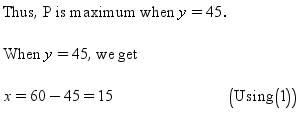
Thus, the two positive numbers are 15 and 45.
x + y = 60
⇒ x = 60 – y ...(1)
Let P = xy3
∴ P =(60 – y)y3 = 60y3 – y4
Differentiating both sides with respect to y, we get

For maximum or minimum dP/dy = 0
⇒ 180y2 - 4y3 = 0
⇒ 4y2 (45 - y) = 0
⇒ y = 0 or 45 - y = 0
⇒ y = 0 or y = 45
⇒ y = 45 (∵ y = 0 is not possible)


Thus, the two positive numbers are 15 and 45.
 is equal to
is equal to - a)1/6
- b)

- c)

- d)0
Correct answer is option 'C'. Can you explain this answer?
 is equal to
is equal to a)
1/6
b)
c)
d)
0
|
|
Stan answered |
Sinx -x/x^3 it is in 0/0 form
so use L hospital rule,
using it we get : cosX-1/3x^2
again using : -sinX/3*2X=-1/6 lim sinx/x=-1/6
If f(x) = 2, then 
- a)2
- b)1
- c)4
- d)0
Correct answer is option 'A'. Can you explain this answer?
If f(x) = 2, then 
a)
2
b)
1
c)
4
d)
0
|
|
Pooja Shah answered |
f(x) = 2
Hence it doesnt contain any variable
so, lim(x → 2) f(x) = 2
Hence it doesnt contain any variable
so, lim(x → 2) f(x) = 2
If the right and left hand limits coincide, we call that common value as the limit of f(x) at x = a and denote it by- a)

- b)

- c)

- d)

Correct answer is option 'D'. Can you explain this answer?
If the right and left hand limits coincide, we call that common value as the limit of f(x) at x = a and denote it by
a)
b)
c)
d)
|
|
Gaurav Kumar answered |
If the right-hand and left-hand limits coincide, we say the common value as the limit of f(x) at x = a and denote it by limx→a f(x) = l
- If limx→a- f(x) is the expected value of f at x = a given the values of ‘f’ near x to the left of a. This value is known as the left-hand limit of ‘f’ at a.
- If limx→a+ f(x) is the expected value of f at x = a given the values of ‘f’ near x to the right of a. This value is known as the right-hand limit of f(x) at a.
The maximum value of  is
is- a)(1/e)1/e
- b)(e)2/e
- c)(e)-1/e
- d)(e)1/e
Correct answer is option 'D'. Can you explain this answer?
The maximum value of  is
is
a)
(1/e)1/e
b)
(e)2/e
c)
(e)-1/e
d)
(e)1/e

|
Shiksha Academy answered |
For every real number (or) valued function f(x), the values of x which satisfies the equation f1(x)=0 are the point of it's local and global maxima or minima.
This occurs due to the fact that, at the point of maxima or minima, the curve of the function has a zero slope.
We have function f(x) = (1/x)x
We will be using the equation, y = (1/x)x
Taking in both sides we get
ln y = −xlnx
Differentiating both sides with respect to x.y.
dy/dx = −lnx−1
dy/dx =−y(lnx+1)
Equating dy/dx to 0, we get
−y(lnx+1)=0
Since y is an exponential function it can never be equal to zero, hence
lnx +1 = 0
lnx = −1
x = e(−1)
So, for the maximum value we put x = e^(−1)in f(x) to get the value of f(x) at the point.
f(e^−1) = e(1/e).
Hence the maximum value of the function is (e)1/e
This occurs due to the fact that, at the point of maxima or minima, the curve of the function has a zero slope.
We have function f(x) = (1/x)x
We will be using the equation, y = (1/x)x
Taking in both sides we get
ln y = −xlnx
Differentiating both sides with respect to x.y.
dy/dx = −lnx−1
dy/dx =−y(lnx+1)
Equating dy/dx to 0, we get
−y(lnx+1)=0
Since y is an exponential function it can never be equal to zero, hence
lnx +1 = 0
lnx = −1
x = e(−1)
So, for the maximum value we put x = e^(−1)in f(x) to get the value of f(x) at the point.
f(e^−1) = e(1/e).
Hence the maximum value of the function is (e)1/e
The volume of cube is increasing at the constant rate of 3 cm3/s. Find the rate of change of edge of the cube when its edge is 5 cm.- a)25 cm3/sec
- b)25 cm/s
- c)1/25 cm/s
- d)1/25 cm3/s
Correct answer is option 'C'. Can you explain this answer?
The volume of cube is increasing at the constant rate of 3 cm3/s. Find the rate of change of edge of the cube when its edge is 5 cm.
a)
25 cm3/sec
b)
25 cm/s
c)
1/25 cm/s
d)
1/25 cm3/s
|
|
Aryan Khanna answered |
Let V be the instantaneous volume of the cube.
dV/dt = 3 cm3/s
Let x be the side of the cube.
V = x3
dV/dt = 3x2 * (dx/dt)
3 = 3*(52)*(dx/dt)
So, dx/dt = 1/25 cm/s
dV/dt = 3 cm3/s
Let x be the side of the cube.
V = x3
dV/dt = 3x2 * (dx/dt)
3 = 3*(52)*(dx/dt)
So, dx/dt = 1/25 cm/s
The derivate of the function 
- a)

- b)

- c)

- d)

Correct answer is option 'D'. Can you explain this answer?
The derivate of the function 
a)
b)
c)
d)
|
|
Gaurav Kumar answered |
Given, y = (sinx+cosx)/(sinx−cosx)
∴ dydx = [(sinx−cosx)(cosx−sinx)−(sinx+cosx)(cosx+sinx)]/(sinx−cosx)2
[by quotient rule]
= [(−sinx−cosx)2 − (sinx+cosx)2]/(sinx−cosx)2
− [(sinx−cosx)2 − (sinx+cosx)2]/(sinx−cosx)2
= − [(sin2x + cos2x − 2sinxcosx + sin2x + cos2x + 2sinxcosx)]/(sinx−cosx)2
= −2/(sinx−cosx)2
= -2/(sin2x + cos2x - 2sinxcosx)
= - 2/(1 - sin2x)
∴ dydx = [(sinx−cosx)(cosx−sinx)−(sinx+cosx)(cosx+sinx)]/(sinx−cosx)2
[by quotient rule]
= [(−sinx−cosx)2 − (sinx+cosx)2]/(sinx−cosx)2
− [(sinx−cosx)2 − (sinx+cosx)2]/(sinx−cosx)2
= − [(sin2x + cos2x − 2sinxcosx + sin2x + cos2x + 2sinxcosx)]/(sinx−cosx)2
= −2/(sinx−cosx)2
= -2/(sin2x + cos2x - 2sinxcosx)
= - 2/(1 - sin2x)

- a)π – 22/7
- b)π
- c)0
- d)(7x-22)/7
Correct answer is option 'A'. Can you explain this answer?
a)
π – 22/7
b)
π
c)
0
d)
(7x-22)/7
|
|
Lavanya Menon answered |
lim(x → π ) (x - 22/7)
Taking limit, we get
⇒ π - 22/7
Taking limit, we get
⇒ π - 22/7
f(x) = x5 – 5x4 + 5x3 – 1. The local maxima of the function f(x) is at x =- a)1
- b)5
- c)0
- d)3
Correct answer is option 'A'. Can you explain this answer?
f(x) = x5 – 5x4 + 5x3 – 1. The local maxima of the function f(x) is at x =
a)
1
b)
5
c)
0
d)
3
|
|
Rajat Patel answered |
f′(x)=5x4−20x3+15x2
f′(x)=5x2(x2−4x+3)
when f′(x)=0
⇒5x2(x2−4x+3)=0
⇒5x2(x−3)(x−1)=0
⇒x=0,x=3,x=1
In case of strict decreasing functions, slope of tangent and hence derivative is
- a)Negative
- b)either negative or zero.
- c)Zero
- d)Positive
Correct answer is option 'A'. Can you explain this answer?
In case of strict decreasing functions, slope of tangent and hence derivative is
a)
Negative
b)
either negative or zero.
c)
Zero
d)
Positive

|
Avantika Joshi answered |
In the case of strictly decreasing functions, the slope of the tangent line is always negative. This implies that the derivative of a strictly decreasing function is always negative. The derivative represents the rate of change of the function, and if the function is strictly decreasing, the rate of change is negative.

- a)sin2x
- b)tan2x
- c)2sinx
- d)cos2x
Correct answer is option 'D'. Can you explain this answer?
a)
sin2x
b)
tan2x
c)
2sinx
d)
cos2x
|
|
Aniketsinh Chundavat answered |
Use, the law of multiplication for derivation
solution:- d/dx ((sinx)(cosx))
= sinx d/dx( cosx) + cosx d/dx (sinx)
= - sinx^2 + cosx^2
= cosx^2 - sinx^2
= cos2x
solution:- d/dx ((sinx)(cosx))
= sinx d/dx( cosx) + cosx d/dx (sinx)
= - sinx^2 + cosx^2
= cosx^2 - sinx^2
= cos2x
Let f (x) be differentiable in (0, 4) and f (2) = f (3) and S = {c : 2 < c < 3, f’ (c) = 0} then- a)S has exactly one point
- b)S = { }
- c)S has atleast one point
- d)none of these
Correct answer is option 'C'. Can you explain this answer?
Let f (x) be differentiable in (0, 4) and f (2) = f (3) and S = {c : 2 < c < 3, f’ (c) = 0} then
a)
S has exactly one point
b)
S = { }
c)
S has atleast one point
d)
none of these

|
Nandini Choudhury answered |
Conditions of Rolle’s Theorem are satisfied by f(x) in [2,3].Hence there exist atleast one real c in (2, 3) s.t. f ‘(c) = 0 . Therefore , the set S contains atleast one element
The function f (x) = x3 has a- a)point of inflexion at = 0
- b)local minima at x = 0
- c)local maxima at x = 0
- d)none of these
Correct answer is option 'A'. Can you explain this answer?
The function f (x) = x3 has a
a)
point of inflexion at = 0
b)
local minima at x = 0
c)
local maxima at x = 0
d)
none of these

|
Amrita Sarkar answered |
f ‘(0) = 0 , f ‘’ (0) = 0 and f ‘’’(0) = 6 . So, f has a point of inflexion at 0.
If the line y=x is a tangent to the parabola y=ax2+bx+c at the point (1,1) and the curve passes through (−1,0), then- a) a=b=−1, c=3
- b) a=b=1/2, c=0
- c) a=c=1/4, b=1/2
- d) a=0, b=c=1/2
Correct answer is option 'C'. Can you explain this answer?
If the line y=x is a tangent to the parabola y=ax2+bx+c at the point (1,1) and the curve passes through (−1,0), then
a)
a=b=−1, c=3
b)
a=b=1/2, c=0
c)
a=c=1/4, b=1/2
d)
a=0, b=c=1/2
|
|
Rajesh Gupta answered |
The correct option is C
a=c=1/4, b=1/2
y=x is a tangent
∴ slopes are equal.
dy/dx=2ax+b
⇒1=2a+b at (1,1)⋯(1)
Also, the parabola passes through (1,1)
⇒a+b+c=1⋯(2)
The parabola passes through (−1,0)
⇒0=a−b+c⋯(3)
Solving (1),(2),(3), we get -
∴a=c=1/4
and b=1/2
a=c=1/4, b=1/2
y=x is a tangent
∴ slopes are equal.
dy/dx=2ax+b
⇒1=2a+b at (1,1)⋯(1)
Also, the parabola passes through (1,1)
⇒a+b+c=1⋯(2)
The parabola passes through (−1,0)
⇒0=a−b+c⋯(3)
Solving (1),(2),(3), we get -
∴a=c=1/4
and b=1/2
Chapter doubts & questions for Differentiation & Its Applications - Mathematics for JAMB 2025 is part of JAMB exam preparation. The chapters have been prepared according to the JAMB exam syllabus. The Chapter doubts & questions, notes, tests & MCQs are made for JAMB 2025 Exam. Find important definitions, questions, notes, meanings, examples, exercises, MCQs and online tests here.
Chapter doubts & questions of Differentiation & Its Applications - Mathematics for JAMB in English & Hindi are available as part of JAMB exam.
Download more important topics, notes, lectures and mock test series for JAMB Exam by signing up for free.
Mathematics for JAMB
134 videos|94 docs|102 tests
|

Contact Support
Our team is online on weekdays between 10 AM - 7 PM
Typical reply within 3 hours
|
Free Exam Preparation
at your Fingertips!
Access Free Study Material - Test Series, Structured Courses, Free Videos & Study Notes and Prepare for Your Exam With Ease

 Join the 10M+ students on EduRev
Join the 10M+ students on EduRev
|

|
Create your account for free
OR
Forgot Password
OR
Signup to see your scores
go up within 7 days!
Access 1000+ FREE Docs, Videos and Tests
Takes less than 10 seconds to signup

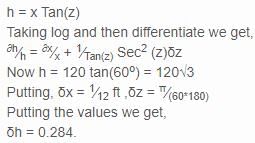


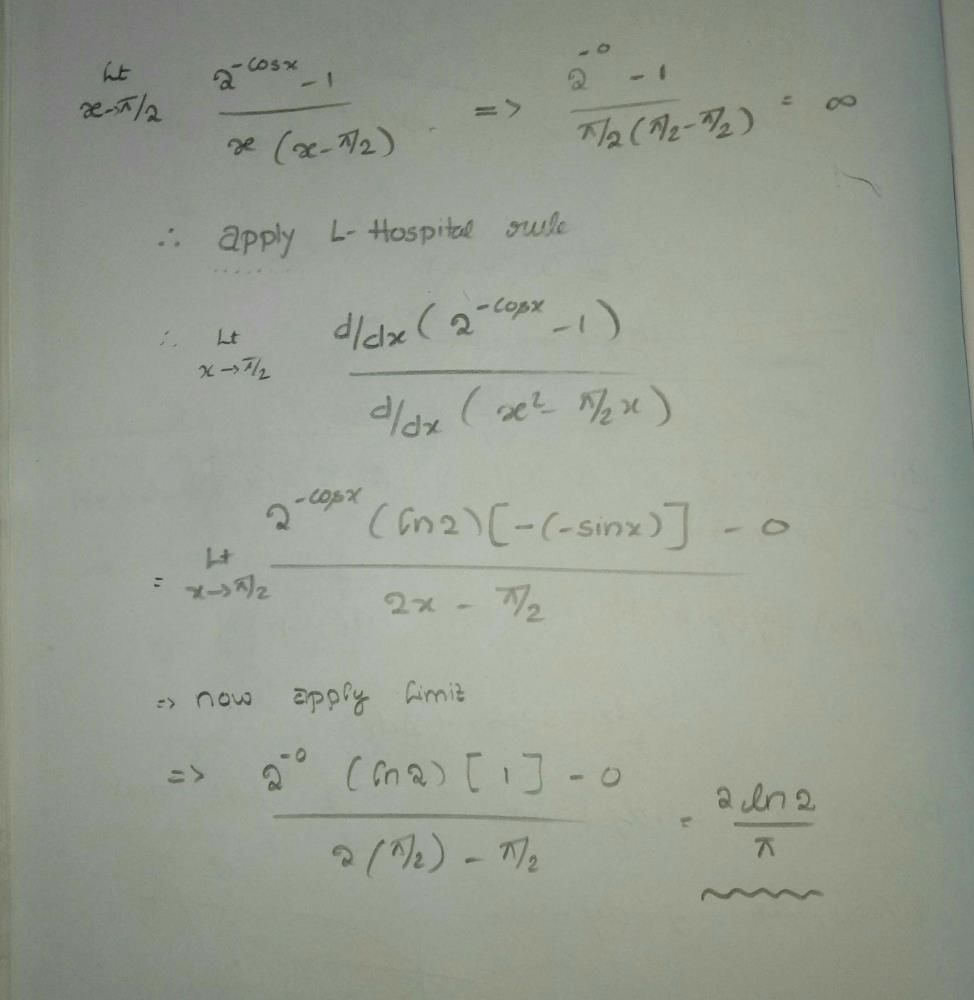

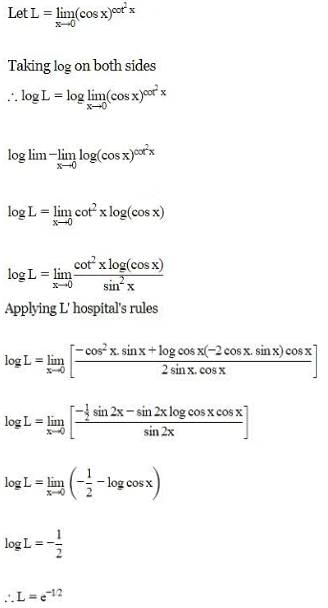

 is equal to
is equal to

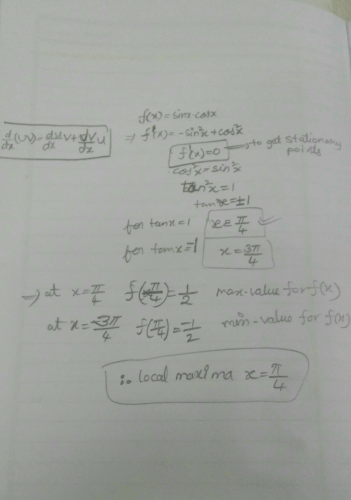
 is equal to
is equal to 
